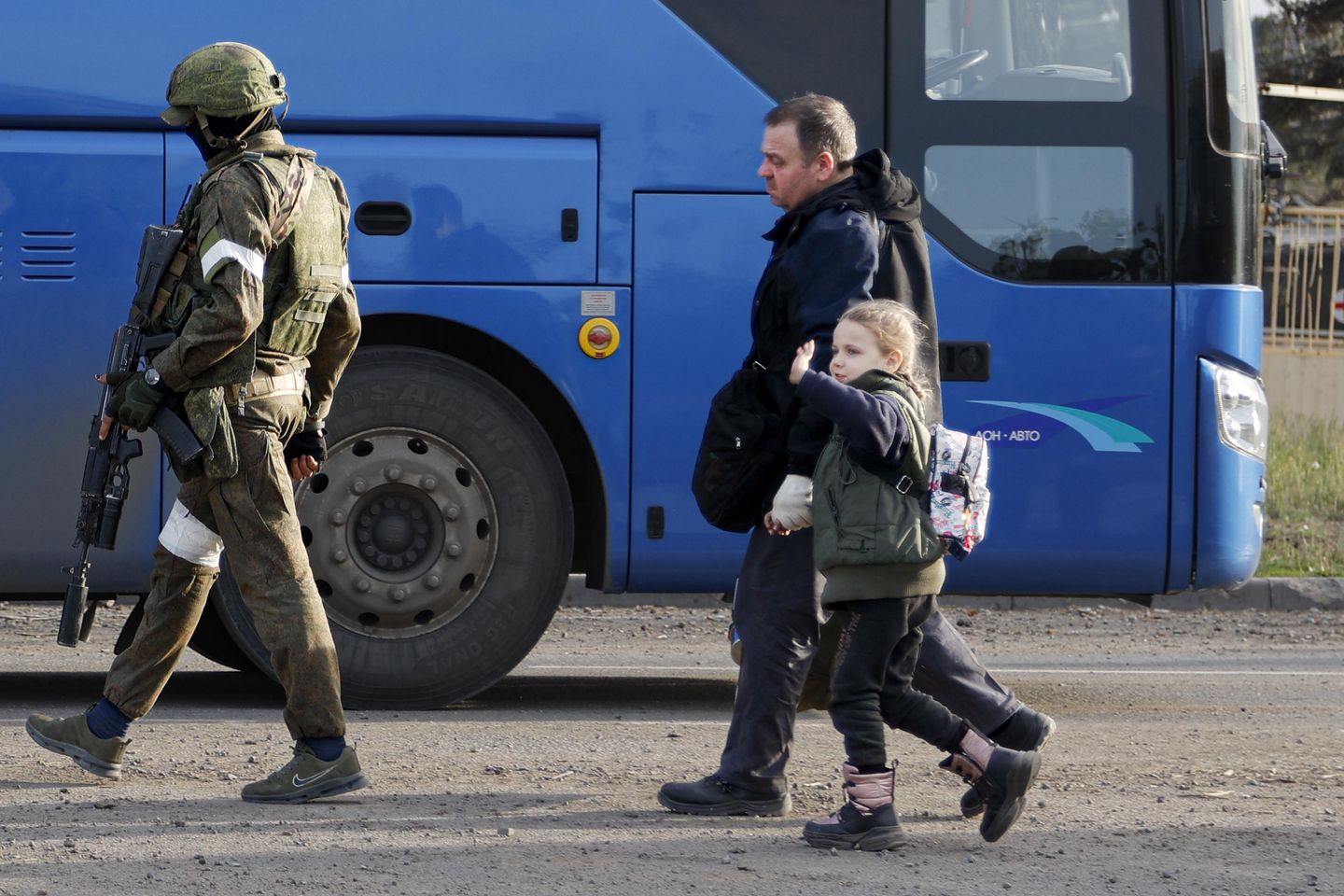

ZAPORIZHZHIA, Ukraine — Ukrainian troops solidified their positions around the nation’s second-largest city Saturday as Russian forces delivered more punishing attacks on an embattled steelworks in a bid to complete their conquest of the southern port of Mariupol in time for Victory Day celebrations.
As Monday’s holiday commemorating the Soviet Union’s World War II victory over Nazi Germany approached, cities across Ukraine prepared for an expected increase in Russian attacks. Officials urged residents numbed by more than 10 weeks of war to heed air raid warnings.
“These symbolic dates are to the Russian aggressor like red to a bull,” Ukraine’s first deputy interior minister, Yevhen Yenin, said. “While the entire civilized world remembers the victims of terrible wars on these days, the Russian Federation wants parades and is preparing to dance over bones in Mariupol.”
The most intense fighting in recent days has befallen eastern Ukraine, where the two sides are entrenched in a fierce race to capture territory not under their control. Western military analysts said a Ukrainian counter-offensive was advancing around the northeastern city of Kharkiv while the Russians made minor gains in Luhansk, an area where Moscow-backed separatists have fought since 2014.
Against that backdrop, Ukrainian fighters were making a final stand to prevent a complete takeover of Mariupol. Securing the strategically important Sea of Azov port that would give Moscow a land bridge to the Crimea Peninsula, which Russia annexed from Ukraine during a 2014 invasion.
New satellite photos analyzed by The Associated Press showed vast devastation at a sprawling seaside steel mill that is the last corner of Ukrainian resistance in the city. Buildings at the Azovstal plant, including one under which hundreds of fighters and civilians are likely hiding, had large, gaping holes in the roof, according to the images shot Friday by Planet Labs PBC.
The bombardment of the steel mill intensified in recent days despite a Russian pledge for a temporary cease-fire to allow civilians inside to escape. Russia has used mortars, artillery, truck-mounted rocket systems, aerial bombardment and shelling from sea to target the facility.
Rescuers sought to evacuate more civilians on Saturday after a week of on-and-off convoys to get people out of Mariupol. Dozens of civilians were delivered Friday to the care of United Nations and International Committee of the Red Cross representatives, Russian and Ukrainian officials confirmed. The Russian military said the group of 50 included 11 children.
The latest evacuees followed roughly 500 others who were allowed to leave the plant and other parts of the city in recent days.
The Ukrainian government has called on international organizations to also help evacuate the fighters defending the plant. By Russia’s most recent estimate, roughly 2,000 Ukrainian fighters remained at the Azovstal steelworks. They have repeatedly refused to surrender.
Ukrainian President Volodymyr Zelenskyy said “influential states” were involved in efforts to rescue the soldiers, although he did not mention any by name.
“We are also working on diplomatic options to save our troops who are still at Azovstal,” he said in his nightly video address early Saturday.
While they pounded away at the plant, Russian forces struggled to make significant gains elsewhere nearly 2 1/2 months into a ruinous war that has killed thousands of people, forced millions to flee Ukraine and flattened large swaths of some cities.
Kharkiv, which was the first Soviet capital in Ukraine, remained a key target of Russian shelling, the Ukrainian military said. The Ukrainian army said it made progress around the hotly contested city with a pre-war population of about 1.4 million, recapturing five villages and part of a sixth.
A Washington-based think tank, the Institute for the Study of War, said in its most recent assessment that Ukraine’s military may be able to push Russian forces “out of artillery range of Kharkiv in the coming days,” providing a respite for the city and an opportunity to build the defenders’ momentum “into a successful, broader counteroffensive.”
Zelenskyy said in his nightly address that the “extraordinary strength of the Ukrainian position” lies in all the countries of the free world understanding what is at stake in the ruinous war.
“We are defending ourselves against an onslaught of tyranny that wants to destroy everything that freedom gives to people and states,” the Ukrainian leader said. “And such a struggle, for freedom and against tyranny, is fully comprehensible for any society, in any corner of the globe.”
In other developments:
– Four Russian cruise missiles fired from aircraft hit the region of Odesa, where authorities have a curfew in place until Tuesday morning. Natalia Humeniuk, the spokesperson for the Ukrainian military’s southern operational command, made the announcement Saturday afternoon as air raid sirens sounded throughout much of the country. She said the strike targeted the city of Arcyz and no one was injured.
– Satellite photos analyzed by the AP showed Ukraine targeting a Russian-held island off its coast in a bid to impede Russia’s efforts to control the Black Sea. The image from Planet Labs PBC showed thick black smoke rising off Snake Island, some 35 kilometers (20 miles) off the coast of Ukraine.
Ukrainian officials in the last day released drone footage suggesting that Turkish-made Bayraktar TB-2 drones launched strikes on the island. The satellite images analyzed by the AP provided the first independent confirmation of the strikes.
– A Russian missile on Saturday destroyed a Ukrainian national museum dedicated to the life and work of an 18th-century philosopher, the local council said. It posted photographs on Facebook showing the Gregory Skovoroda museum engulfed in flames.
As an indication of his importance to Ukraine’s cultural heritage, Skovoroda’s likeness adorns a Ukrainian banknote. The museum in Skovorodynivka lies near the Russian border in the Kharkiv region where fighting has been fierce.
